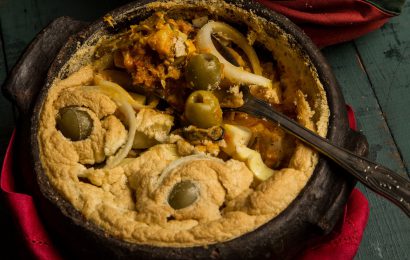
Makes: Serves 4-6

Preparation Time: 3 hours

Level: Medium/ Difficult
INGREDIENTS
FOR THE DOUGH
- 500 G OF ALL-PURPOSE FLOUR
- 300 G OF LARD OR UNSALTED BUTTER
- 2 EGGS AND 1 YOLK
FOR THE FILLING
- 2 TABLESPOONS OF OLIVE OIL
- ½ ONION, DICED
- 2 GARLIC CLOVES, MINCED
- 6 PEELED AND DESEEDED TOMATOES, CHOPPED
- 2 FRESH SAUSAGES
- 1½ TEACUP OF DICED COOKED CHICKEN
- 1 TEASPOON OF TOMATO PASTE
- 1 BITTER COCONUT PALM, COOKED IN SMALL PIECES
- 3 HARD-BOILED EGGS, DICED
- 1 TEACUP OF DICED MEIA-CURA CHEESE
- ½ TEACUP OF CHOPPED GREEN OLIVES
- ½ BUNCH OF PARSLEY, CHOPPED
- SALT AND BLACK PEPPER TO TASTE
PREPARATION
For the dough, mix the flour with the lard. Add the eggs (set the yolk aside) and, slowly, mix in 95 ml of water with salt. The dough should be ready when it’s soft and no longer sticks to the hands. Allow it to rest for 1 hour, outside of the fridge, while you prepare the filling. Heat up the olive oil and braise the onion, garlic, and tomato until they whiter. Add the sausage, without the casing, and stir until it’s cooked through. Add the chicken and tomato paste. Stir and add the bitter coconut palm, eggs, cheese, olives, and parsley. Taste, adjust seasoning, and wait for it cool. Roll out two thirds of the dough using a rolling pin (set a plastic wrap over it, so it won’t stick) and line the bottom and the sides of a clay pot with 15 cm of diameter. Put in the filling and cover with the remaining dough, previously rolled out. With the leftover dough, seal the edge of the lid, covering possible gaps. Brush the egg yolk on the crust and bake at 180°C for 40 minutes, or until golden.
IN DETAIL: The “empadão” quickly became known during the 80’s, when it was added to the menu of a restaurant at the Centro de Tradições Goianas, in Goiás. Today, it reached beyond state borders and is one of the best-known dishes in Mid-West. Pork loin, pequi, sausages, heart of palm, and boiled eggs are among the ingredients used for the filling.


